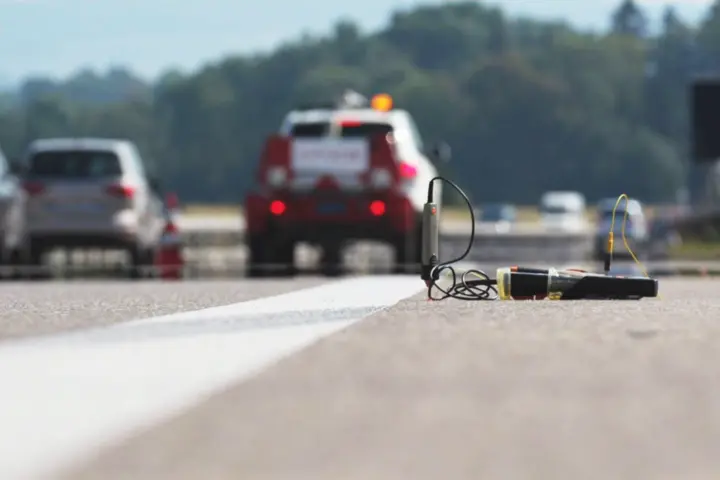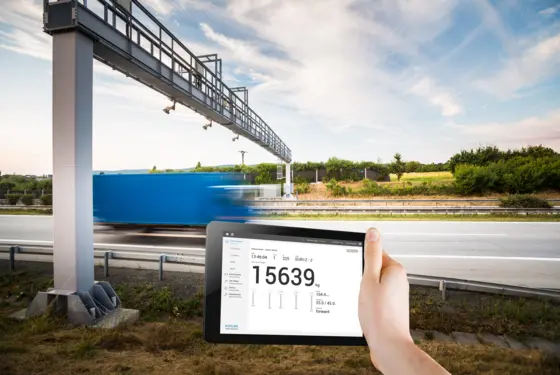Know your road thanks to in-depth analysis
One of the first customers to benefit from the new SRA service was SPEL, the local system integrator designated by the Road and Motorway Directorate of the Czech Republic (ŘSD ČR). For a planned extension to an existing WIM site at kilometer 8.3 of the D2 highway linking Břeclav and Brno, a full SRA was conducted over a length of 150 meters on both Brno-bound lanes. The goal: to identify the optimum location and best sensor layout to ensure optimum performance and maximum overall lifetime for the WIM system.
An earlier investigation had already highlighted the challenges presented by the road's condition, so a full-scale analysis was undertaken including road surface measurement, measurement of pavement bearing capacity (using FWD), and measurement of IRI and rut depth to determine the road's longitudinal and transversal unevenness. Based on the results, the pavement structure was modeled and the elastic modulus of each layer was calculated. The final report from Kistler to SPEL included an in-depth analysis and evaluation together with practical recommendations on system configuration and sensor layout.
"Kistler handled the management of the entire project, including the IRI and FWD measurement services provided by two local partners. What's more, they gave us a full report on road quality along with specific recommendations on how to improve the WIM site. We were highly impressed by the results of their work."
Miroslav Kolda, Production and Technical Director at SPEL
Data-driven recommendations enable WIM optimization
What were the results of the Structural Road Analysis? First of all, the base layers of both lanes were found to be fairly heterogeneous: however, the soil contains significant amounts of water that could have a seasonal effect on measuring accuracy and even lead to road damage. Rutting values at some points actually exceed the levels permitted for monitoring applications, so the locations for installing the sensors must be chosen very carefully. Lane one shows better overall quality and is suitable for direct enforcement in its existing state, but three rows of WIM sensors (instead of two) are recommended here. On the other hand, the analysis showed that the WIM system on lane two does not meet the requirements for direct enforcement in its present state. Four rows of Kistler Lineas sensors are necessary to achieve the desired GVW accuracy here.
A simulation model was calculated to determine the best sensor layout, taking account of profile data from both lanes. The model comprises eight vehicles that are each simulated in both empty and fully loaded conditions. On this basis, a location between meters 68 and 84 of the highway section was determined as the best position for the sensor installation. Kistler also provided a detailed graphical layout recommendation, with different sensor arrangements and intermediate distances for lanes one and two (see image).
SPEL was so impressed by this experience of the Structural Road Analysis that the integrator has now decided to use it for every upcoming WIM installation. “All the information generated by these tests is very valuable for us: knowing the right number of sensors, the best location, ideal layout and intermediate distances saves us a lot of time and money later on,” Kolda points out. In the meantime, SPEL has commissioned a second full SRA service. Discussions are now under way with ŘSD ČR about the possible introduction of a mandatory requirement for structural road analyses, so the new service from Kistler could be specified for all WIM installations in the Czech Republic in the future.
Michal Izak, Sales Engineer Traffic Solutions Eastern Europe at Kistler, comments: “This is the best endorsement we could possibly get for the SRA – our Structural Road Analysis service. We're glad to have shown in practice that these analyses are fully worth the effort. It's simply the right way to go for direct enforcement applications – both for large-scale systems and single WIM installations. We've already received a request from another system integrator in the Czech Republic – and I'm sure other countries will follow soon.”








![Locating the ideal Weigh In Motion site [object Object]](https://kistler.cdn.celum.cloud/SAPCommerce_Document_Preview/961-554e.webp)